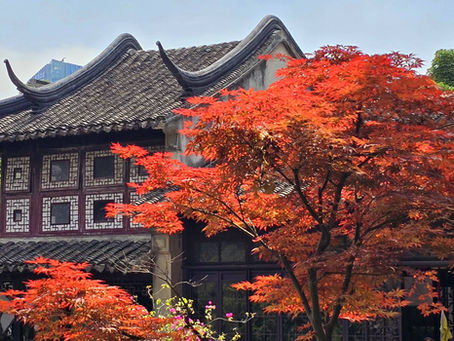top of page

GLOBAL SHANANIGANS

Search


Wat Chedi Luang
Commissioned under King Saen Muangma in the late 14th century, this ancient royal monastery stands among Chiang Mai’s most venerated temples. Originally envisioned as a monumental reliquary to honour and enshrine the ashes of his father, King Ku Na, it was to rise as a symbol of royal devotion and divine aspiration. Yet destiny had other plans.
Shannon


The Temple of Literature
Founded in 1070 AD under Emperor Lý Thánh Tông, the Temple of Literature honours Confucius and his disciples, its courtyards, banyan trees and lotus ponds echoing centuries of scholarly pursuit. Later home to Vietnam’s first university, it carries the weight of history and the whispered presence of generations of students, a place where wisdom feels alive, shadowed by the spirits of those who once walked its paths.
Shannon


Kajeng Rice Fields Loop
Slicing through glittering, gently terraced rice fields and fringed by towering coconut palms, the Kajeng Rice Fields Walk is arguably one of the prettiest treks you can do in the cultural capital of Ubud without a guide. Kajeng offers a rare and intimate glimpse into Bali’s traditional agricultural life, set against a landscape that’s both serene and alive with quiet purpose.
Shannon


The Rice Terraces of Tegallalang
Carved like emerald steps into Ubud’s natural amphitheatres, locals say the spirit of the rice goddess still watches over the iconic Tegallalang Rice Terrace, blessing the fields with life and balance. Also known as Ceking, the terraces are a large collection of beautiful verdant rice paddies, carved into the hillside by generations of farmers and shaped by centuries of Balinese ingenuity.
Shannon


Taman Ayun - The Royal Playground
Encircled by a wide moat and wrapped in manicured geometric gardens, Pura Taman Ayun looks more like a mythical vision than a temple. This 17th-century royal fortress served as the royal temple of the once mighty Mengwi kingdom and was designed not just to honour the gods but to remind subjects of the divine order that placed kings just beneath them.
Shannon


Pura Ulun Danu Batur - The Temple of Ash and Mercy
First established in the 17th century, Pura Batur is one of Bali’s most venerated temples, second only to Pura Besakih on the sacred slopes of Mount Agung. Perched at roughly 900 metres above sea level, this mountain sanctuary overlooks the dramatic caldera of Mount Batur, an active volcano steeped in myth and raw geological power.
Shannon


Besakih Temple
The origins of Pura Besakih are veiled in ancient legend, its story whispered through centuries beyond recorded memory. For more than a thousand years, this sprawling temple complex has stood as the spiritual heart and the “Mother Temple” of the whole island. Perched nearly a kilometre above the sea, on the jagged southwestern flank of Mount Agung, it commands a breathtaking view and an air of sacred power.
Shannon


Ayutthaya - The Fallen City of Siam
Once the jewel of Siam, Ayutthaya now lies in silence, its streets soaked in blood and its temples crumbling under the weight of history. Execution grounds, ruined chedis, and desecrated monasteries bear witness to the brutal fall at the hands of the Burmese army, where kings, monks, and nobles met violent ends. The shadows of the city are said to whisper with the voices of the betrayed and the slain, a restless reminder that even in ruin, Ayutthaya’s dark legacy refuses to f
Shannon


Jatiluwih Rice Terraces
The village of Jatiluwih offers a living testament to the ancient harmony between humans, nature and the divine. Overlooked by the brooding silhouette of Mount Batukaru, Bali’s second-highest volcano and a sacred site in its own right, Jatiluwih’s name translates to "truly beautiful," a title it lives up to with dramatic sweeps of emerald-green rice terraces that ripple across the landscape.
Shannon


Sacred Tombs of The Pagoda Forest
Located at the base of Mount Shaoshi in Henan Province, the Pagoda Forest at Shaolin Temple is a sacred necropolis within the broader monastery complex. With its origins tracing back to 618 AD during the Tang Dynasty, the forest is home to over 240 stone and brick pagodas, each serving as a tomb or memorial for esteemed monks, abbots and martial art masters.
Shannon


The Birth of Apsaras - Daughters of the Ocean of Milk
Apsaras, the celestial nymphs of Hindu and Buddhist mythology, are revered for their unparalleled beauty, graceful movements and mastery of dance and music. Adorned with golden skin, fragrant hair and flowing garments, they appear throughout ancient texts as divine attendants in the heavenly courts of gods like Indra, where they serve as entertainers and symbols of spiritual and aesthetic refinement.
Shannon


Bailong Elevator - In the Shadow of Dragons
Rising like a gleaming spine along the raw sandstone cliffs of Zhangjiajie National Forest Park in China’s Hunan Province, the Bailong Elevator, also known as the "Hundred Dragons Elevator" is both a marvel of modern engineering and a looming monolith that stirs ancient fears. Piercing 326 metres into the sky, it is the tallest outdoor elevator in the world.
Shannon


The Lingering Garden
In a city celebrated for its canals, silk and scholars, Suzhou’s Lingering Garden represents a pinnacle of classical Chinese garden design. Often referred to as one of the “Four Great Classical Gardens of China,” it embodies centuries of artistic refinement and philosophical thought. Built in 1593 during the Ming dynasty by Xu Taishi, a high-ranking official who sought retirement and tranquility, the garden stands as a personal reflection of his scholarly ideals.
Shannon


Beneath the Dragon - Imperial Citadel of Thăng Long
Constructed on the remains of a 7th century Chinese fortress, the Thăng Long Imperial Citadel was built on strategic reclaimed river lands on the lower Red River Delta and for nearly 13 centuries, remained the regional powerhouse of Northern Vietnamese political & military domination. Shortly after his ascension to the throne, Emperor Lý Thái Tổ declared a royal decree in the year 1010, to move the capital from Hoa Lư and establish a new Imperial City for the Lý Dynasty.
Shannon


Sacred Nara Deer Park
Although not formally declared a public park until 1880, the sacred origins of Nara Park stretch back to 708AD, when Japan’s capital was transferred to the Heijo Palace area, now the city of Nara. As the heart of early Japanese civilisation, Nara became a place where political ambition, religious reverence and spiritual mystery intertwined.
Shannon


Kongōbu-ji Temple - The Heart of Shingon Buddhism
Founded in 1593 by the powerful samurai warlord Toyotomi Hideyoshi, Kongōbu-ji was established as a spiritual monument dedicated to immortalising his mother. This temple’s creation was more than just an act of filial piety, it became a lasting symbol of religious devotion and architectural mastery. Nestled in Koyasan, Kongōbu-ji quickly rose to prominence as a central hub for Shingon Buddhism, intertwining Hideyoshi’s legacy with the sacred landscape of Japan.
Shannon


Sacred Mount Kōyasan
Mount Kōya, or Kōyasan, was first settled in 819AD by the legendary monk Kūkai, also known as Kōbō Daishi, who introduced esoteric Shingon Buddhism to Japan after studying in China. Nestled in a secluded alpine basin surrounded by eight lotus-like peaks, this sacred site in Wakayama Prefecture was chosen for its geomantic significance and spiritual isolation. By imperial decree in 816, Kūkai began transforming the mountaintop into a monastic haven.
Shannon


The Killing Fields - Cambodia's Genocide
Located in the dusty outskirts of Phnom Penh lies Choeung Ek, the most infamous of Cambodia’s killing fields. Once a peaceful longan orchard, it now stands as a site of incomprehensible horror and grief. While over 300 killing fields have been identified throughout the country, Choeung Ek alone bore witness to the execution of more than 17,000 men, women and children during the Khmer Rouge regime.
Shannon


The Leshan Buddha - Guardian of the Rivers
In the heart of Sichuan Province, nestled at the confluence of the Min, Dadu and Qingyi Rivers, the Leshan Giant Buddha looms as one of China’s most awe inspiring historical landmarks. Towering at 71 metres high, this colossal statue is the largest stone Buddha in the world and remains a profound testament to ancient Chinese ingenuity and spiritual devotion.
Shannon


Bayon - The Temple of Faces
Built around 1190AD during the reign of the powerful King Jayavarman VII, Bayon stood at the symbolic heart of Angkor Thom, the ancient capital of the Khmer Empire. From a distance, the temple may appear as little more than a chaotic pile of stone, but step closer and it transforms into a breathtaking showcase of Khmer "baroque" architecture.
Shannon
bottom of page